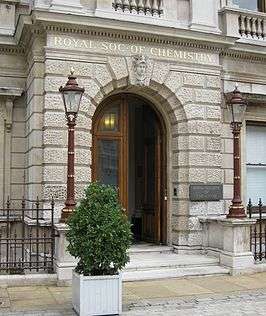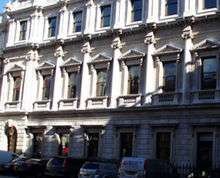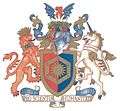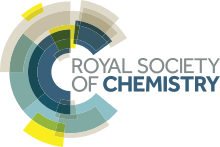Royal Society of Chemistry
|
The RSC's logo, introduced in 2013 | |
| Motto |
Pro scientia et humanitate (For the sake of knowledge and for the benefit of mankind) |
|---|---|
| Formation | 1980 (1841)[1] |
| Type | Learned society |
| Headquarters | London |
| Location |
|
Membership | 51,000 |
Official language | English |
President | John Holman |
Key people | Robert Parker (CEO) |
| Website |
www |

The Royal Society of Chemistry (RSC) is a learned society (professional association) in the United Kingdom with the goal of "advancing the chemical sciences". It was formed in 1980 from the merger of the Chemical Society, the Royal Institute of Chemistry, the Faraday Society, and the Society for Analytical Chemistry with a new Royal Charter and the dual role of learned society and professional body. At its inception, the Society had a combined membership of 34,000 in the UK and a further 8,000 abroad.[2] The headquarters of the Society are at Burlington House, Piccadilly, London. It also has offices in Thomas Graham House in Cambridge (named for Thomas Graham, the first president of the Chemical Society) where RSC Publishing is based. The Society has offices in the United States at the University City Science Center, Philadelphia, in both Beijing and Shanghai, China and Bangalore, India.[3] The organisation carries out research, publishes journals, books and databases, as well as hosting conferences, seminars and workshops. It is the professional body for chemistry in the UK, with the ability to award the status of Chartered Chemist (CChem) and, through the Science Council the awards of Chartered Scientist (CSci), Registered Scientist (RSci) and Registered Science Technician (RScTech) to suitably qualified candidates. The designation FRSC is given to a group of elected Fellows of the society who have made major contributions to chemistry and other interface disciplines such as biological chemistry. The names of Fellows are published each year in The Times (London). Honorary Fellowship of the Society ("HonFRSC") is awarded for distinguished service in the field of chemistry.
President
The president is elected biennially and wears a badge in the form of a spoked wheel, with the standing figure of Joseph Priestley depicted in enamel, mainly in red and blue, on a hexagonal medallion in the centre. The rim of the wheel is gold, and the twelve spokes are of non-tarnishable metals.
The current president is Sir John Holman (2016–2018).[4]
Past presidents of the society have been:
- 1980–1982: Sir Ewart Ray Herbert Jones (1911–2002)
- 1982–1984: Sir John Ivan George Cadogan (1930–)
- 1984–1986: Richard Oswald Chandler Norman (1932–1993)[5]
- 1986–1988: Sir Jack Lewis (1928–2014)[6]
- 1988–1990: John Mason Ward (-2014)
- 1990–1992: Sir Rex Edward Richards (1922– )
- 1992–1994: Charles Wayne Rees (1927–2006)[7]
- 1994–1996: John Howard Purnell (1925–1996)[8]
- 1996–1998: Edward William Abel (1931–)
- 1998–2000: Anthony Ledwith (1933–)[9]
- 2000–2002: Steven Victor Ley (1945–)
- 2002–2004: Sir Harold Kroto (1939–)
- 2004–2006: Simon Campbell (1941–)[10]
- 2006–2008: James Feast (1938–)
- 2008–2010: David Garner (1941–)[11]
- 2010–2012: David Phillips (1939–)[12]
- 2012–2014: Lesley Yellowlees[13] (1953–)
- 2014–2014: Dominic Tildesley[14] (1952–)
Membership grades and post-nominals
The following are membership grades with post-nominals (designatory letters):[15]
- Affiliate: (no post-nominal) The grade for students and those involved in chemistry who do not meet the requirements for the following grades.
- AMRSC: Associate Member, Royal Society of Chemistry The entry level for RSC membership, AMRSC is awarded to graduates (or equivalent) in the chemical sciences.
- MRSC: Member, Royal Society of Chemistry Awarded to graduates (or equivalent) with at least 3 years' experience, who have acquired key skills through professional activity
- FRSC: Fellow of the Royal Society of Chemistry Fellowship may be awarded to nominees who have made an outstanding contribution to chemistry (see Category:Fellows of the Royal Society of Chemistry).
- HonFRSC: Honorary Fellow of the Society Honorary Fellowship is awarded for distinguished service in the field of chemistry.[16]
- CChem: Chartered Chemist The award of CChem is considered separately from admission to a category of RSC membership. Candidates need to be MRSC or FRSC and demonstrate development of specific professional attributes and be in a job which requires their chemical knowledge and skills.
- CSci: Chartered Scientist The RSC is a licensed by the Science Council for the registration of Chartered Scientists.
- EurChem: European Chemist The RSC is a member of the European Communities Chemistry Council (ECCC), and can award this designation to Chartered Chemists.
- MChemA: Mastership in Chemical Analysis The RSC awards this postgraduate qualification which is the UK statutory qualification for practice as a Public Analyst.[17] It requires candidates to submit a portfolio of suitable experience and to take theory papers and a one-day laboratory practical examination.[18]
GRSC
The qualification GRSC (Graduate of the Royal Society of Chemistry) was awarded from 1981 to 1995 for completion of college courses equivalent to a chemistry degree and overseen by the RSC.[19] It replaced the GRIC offered by the Royal Institute of Chemistry.
Divisions
The society is organised around 9 divisions, based on subject areas, and local sections, both in the United Kingdom and overseas. Divisions cover broad areas of chemistry but also contain many special interest groups for more specific areas.
- Analytical Division for analytical chemistry and promoting the original aims of the Society for Analytical Chemistry. 12 Subject Groups.
- Dalton Division, named after John Dalton, for inorganic chemistry. 6 Subject Groups.
- Education Division for chemical education. 4 Subject Groups.
- Faraday Division, named after Michael Faraday, for physical chemistry and promoting the original aims of the Faraday Society. 14 Subject Groups.
- Organic Division for organic chemistry. 6 Subject Groups.
- Chemical Biology Interface Division. 2 Subject Groups.
- Environment, Sustainability and Energy Division. 3 Subject Groups.
- Materials Chemistry Division. 4 Subject Groups.
- Industry and Technology Division. 13 Subject Groups.
There are 12 subjects groups not attached to a division.
Local sections
There are 35 local sections covering the United Kingdom and Ireland. In countries of the Commonwealth of Nations and many other countries there are Local Representatives of the society and often some activities.
Publications
The society is a not-for-profit publisher: surplus made by its publishing business is invested to support its aim of advancing the chemical sciences.
In addition to scientific journals, including its flagship journals Chemical Communications, Chemical Science and Chemical Society Reviews, the society publishes:
- Education in Chemistry for teachers.
- A free online journal for chemistry educators, Chemistry Education Research and Practice.
- A general chemistry magazine Chemistry World, sent monthly to all members of the Society throughout the world. The editorial board consists of 10 academic and industrial chemists. It was first published in January 2004. It replaced Chemistry in Britain, first published in 1965. Its contents include news, articles of a general chemical nature, such as the history of chemistry and technological developments, book reviews and letters from readers. Its ISSN is 1473-7604. Chemistry World is supported by the Chemistry World Podcast, which is presented by Cambridge University scientist Dr Chris Smith, who also edits The Naked Scientists.
- Professional reference books across the chemical sciences.[20]
- Books for students, including the Tutorial Chemistry Texts series of 23 books, edited by E. W. Abel, and the 8 books in the Molecular World series, whose coordinating editor is L. E. Smart.
- Books on the history of chemistry, such as a history of the Faraday Society.
Subscriptions to the journals are available individually, or "all-in", under a provision called "RSC Gold".[21]
Burlington House
 | |
| Established | 2010 |
|---|---|
| Location | Piccadilly, London W1, England |
| Website |
www |
The London offices of the Society are in Burlington House, Piccadilly. Events are hosted here for the public, RSC member groups and external organisations including monthly lectures on the chemical sciences that streamed live via the RSC's public engagement website – the Reaction. The free lectures take an interesting look at the chemical aspects of a wide range of topics from curry to the enjoyment of music.
The events have attracted notable science writers such as Philip Ball, Antony John Williams, and John Emsley to give public lectures. Most of these are available as archived video streams via the RSC's Reaction website.[22]
History
Although opened as the Chemistry Centre in 2010, the building has been occupied by the Royal Society of Chemistry since 1857 (at which time it was known as the Chemical Society) – the heart of the Chemistry Centre is the RSC's Library and Information Centre which itself dates back to 1842. Over the years, the library for the RSC has received many gifts from notable fellows including Michael Faraday. The library became a centre for information on the chemical sciences during the 1st and 2nd world wars when extensive use was made on the chemical reference material available. In November 2014, the society announced that the centre would be rebranded as simply "Royal Society of Chemistry at Burlington House" and the name "Chemistry Centre" dropped.
Library and information centre
The society has a large library covering mainly chemistry-based subjects, including online access for members, housed at the Chemistry Centre at Burlington House. It is part of the Chemistry Centre and is a resource for RSC members, although the public are also welcome.
Benevolent fund

The Royal Society of Chemistry's benevolent fund supports the members and their families during difficult times, through advice and guidance, financial support and volunteer support.[23] It dates back to 1920 when the Institute of Chemistry (later the Royal Institute of Chemistry) established it as a memorial to its members who died in the first world war. It had an aim "to help necessitous persons who are, or have been, Fellows or Associates of the Institute, their wives or children, and the widows and dependent relatives of deceased Fellows and Associates" through voluntary contributions from members. The benevolent fund's ethos of "members helping members" stems from the Institute of Chemistry's Council raising money for members in need from other members prior to the fund being formed.[24]
In 1960, the benevolent fund introduced a volunteer visitor system, where members were asked to visit applicants, beneficiaries, elderly and housebound members in their area. Each local section was also appointed a fund representative.[25]
A major review of the fund to modernize it took place in 2003-2004, forming a new strategy document that is updated every three years. It underwent another review in 2014 with the aim to widen its reach and provide a more holistic support wider than financial assistance to Royal Society of Chemistry members and their families.[26]
The Benevolent Fund Committee, formed of volunteer members of the Royal Society of Chemistry, oversees the benevolent fund and meet every three months.[27]
Prizes and awards
The RSC awards a variety of prizes and awards each year that include awards for excellence in any area of chemistry, in specialist areas or for achievement at particular stages of a chemist's career.[28]
Medals are awarded centrally by the RSC and by the divisions of the organisation. There are also awards that are administered by RSC interest groups.
The centrally awarded medals include the Harrison-Meldola Memorial Prizes which are awarded to a British chemist who is under 32 years of age for promising original investigations in chemistry[29] and the Corday-Morgan medals which consist of three separate awards made for the most meritorious contributions to experimental chemistry (including computer simulation).[30] The Tilden Prize, previously known as the Tilden Lecture, consists of three awards annually to scientists in mid-career for advances in chemistry.
Previous winners of the Harrison-Meldola Prize (known as the Meldola Medal and Prize prior to its merger in 2008 with the Edward Harrison prize) include Christopher Kelk Ingold (1921, 1922), Cyril Norman Hinshelwood (1923), R.H. Stokes (1946), D.H. Williams (1966), and J. Evans (1978).
Corday-Morgan medal recipients include Derek Barton (1949), Ronald Sydney Nyholm (1950), Frederick Sanger (1951), John Cornforth (1953), Rex Richards (1954), and George Porter (1955).
The Faraday Division annually awards the Marlow Award for contributions to physical chemistry or chemical physics by members of the Faraday Division under the age of 32.[31] Recent recipients include Andrew Orr-Ewing, (1999), Jonathan A. Jones, (2000), Helen Fielding (2001), Jonathan Essex (2002), Daren Caruana (2003), Jonathan Reid (2004), Julie Macpherson (2005), Fred Manby (2006), and Alessandro Troisi (2007).
Coat of arms
The RSC has its own coat of arms. Two forms exist: the full coat of arms has lion and unicorn bearers, and the Latin motto "Pro scientia et humanitate" (For the sake of knowledge and for the benefit of mankind). The smaller version uses just the central shield, which is similar to that in the Royal Institute of Chemistry's arms.
-

coat of arms
-

shield
-
Arms on the society's Robert Boyle Prize for Analytical Science medal
Other resources
The Interactive Lab Primer is a site developed to provide tips to a variety of chemical experimentation skills.[32] The site covers basic lab safety tips, demonstrates primary lab techniques, introduces a couple common lab apparatus in lab, and provides other references.
The society's ChemSpider is a database of chemicals and chemical properties.
The society operates a blue plaque scheme, "Landmarks of Chemistry", erecting plaques at places associated with notable chemical events or people.[33] Recent plaques are hexagonal.
References
- ↑ Lagowski, J. J. (1991). "A British Sesquicentennial," Journal of Chemical Education, Vol 68, No. 1, p. 1; acknowledging the sesquicentennial of The Chemical Society in London, which eventually became the Royal Society of Chemistry.
- ↑ "RSC History". Rsc.org. Retrieved 2013-01-08.
- ↑ "RSC Contacts". Rsc.org. Retrieved 2013-01-08.
- ↑ "2015 RSC Elections". 15 June 2015. Retrieved 16 June 2015.
- ↑ Richard Oswald Chandler Norman Obituary in the Independent
- ↑ "404 – Anglia Ruskin University".
- ↑ Charles Wayne Rees Obituary in the Independent
- ↑ Howard Purnell Obituary in the Independent
- ↑ Anthony Ledwith Biography
- ↑ www.rsc.org Press Release 2006 Simon Campbell Biography
- ↑ www.nottingham .ac.uk David Garner
- ↑ www3.imperial.ac.uk David Phillips
- ↑ College of Science and Engineering University of Edinburgh Lesley Yellowlees
- ↑ RSC Press Release 9 July 2014
- ↑ "RSC Website – Designatory Letters". Rsc.org. Retrieved 2013-01-08.
- ↑ "Press release: Lesley Yellowlees pays tribute to Lord Ballyedmond". Royal Society of Chemistry. 14 March 2014. Retrieved 1 October 2014.
- ↑ "Statutory Instrument 1990 No. 2463 The Food Safety (Sampling and Qualifications) Regulations 1990". Opsi.gov.uk. 2012-02-03. Retrieved 2013-01-08.
- ↑ "RSC Web page MChemA". Rsc.org. Retrieved 2013-01-08.
- ↑ www.rsc.org Graduate Qualifications in Chemistry
- ↑ "Royal Society of Chemistry Book Series". www.rsc.org/Shop/books/series/index.asp.
- ↑ "RSC Gold". Royal Society of Chemistry. Retrieved 18 December 2014.
- ↑ "Reaction articles". Royal Society of Chemistry.
- ↑ "Our benevolent fund".
- ↑ "History of the Benevolent Fund". Archived from the original on 2008.
- ↑ "History of the Benevolent Fund". Archived from the original on 2008.
- ↑ "History of the Benevolent Fund". Archived from the original on 2008.
- ↑ "History of the Benevolent Fund". Archived from the original on 2008.
- ↑ "RSC prizes and awards". Rsc.org. Retrieved 2013-01-08.
- ↑ "Harrison-Meldola Memorial Prize". Rsc.org. 2012-09-01. Retrieved 2013-01-08.
- ↑ "Corday-Morgan Prizes". Rsc.org. 2012-09-01. Retrieved 2013-01-08.
- ↑ "Marlow Award". Rsc.org. 2012-09-01. Retrieved 2013-01-08.
- ↑ "chem-ILP".
- ↑ "RSC awards a Blue Plaque to Professor Andrews FRS". Queen's University Belfast. Retrieved 1 October 2014.
External links
| Wikimedia Commons has media related to Royal Society of Chemistry. |
- Official website
- History of the RSC
- Chemistry Centre
- The society's blue plaques at OpenPlaques
- Royal Society of Chemistry’s interactive Periodic Table
- History of the RSC Library and Information Centre
Coordinates: 51°30′32″N 0°08′20″W / 51.5089°N 0.1390°W
